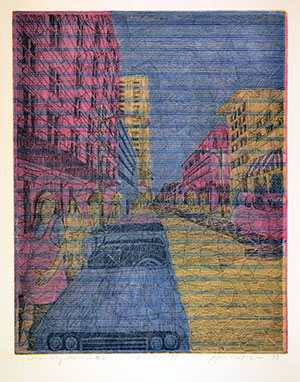
Visual Language To Create Motion


Inner City Series 1#2-Artist Proof, Copper Plate
Burin Engraving by artist Leon Hicks
The intellectual eye analyzes what the visual eye merely perceives. It converts the raw data collected by sight into spiritual or artistic presence.
Visual language is universal. It has no set religion, country, race, gender, borders, or grammar. Both the educated and the uneducated understand it. To create art, one needs only to connect with a subject that inspires him.
If what inspires an artist is a bouquet of orange flowers in front of a blue background, after he finishes painting a picture of what he sees with his eyes, he then shows mastery by modifying and adding different elements according to his passion, experience and style.
Though he may begin the artwork with the visual eye, he finishes with the intellectual eye. Some artists are inspired by color alone. They eliminate the details of shape to create abstractions of pure color and texture.
Perceiving Movement
When observing a landscape while traveling by train, one may notice that the scenes close by seem to move fast and the scenes farther away move more slowly. Still farther from the train, the horizon remains still. Similarly, a flower blossoming or a child growing appears stationary to the visual eye. In the other extreme, an object moves so fast it blurs. Our visual abilities have particular limits on what movement we can and cannot see.
Yet, all objects on earth are subject to visual motion. Brightness and shade change according to the position of the sun. Clouds drift, water runs, people move, and traffic flow. Anything of physical presence cannot escape visual movement.
To build a relationship with these ever-changing scenes, the artist uses the visual image he perceives, the memory of the image as altered by his experience and knowledge, and his mastery to represent it on canvas.
Any changes on the canvas to the visual elements of an object, such as size, shape and brightness may be perceived as motion. Through such modifications, artists can infuse dynamism into the picture plane.
Motion and Abstract Art
In the history of art, visual representation of depth and distance has been found using linear perspective and shading, but visual representation of motion has not been well defined.
To visually represent this movement, artists have fused the different positions of an object in motion and lines of force to signify direction and speed. The attempt to represent movement in an art work has taken prominence in abstract art in particular. To achieve movement, abstract artists organize planes of color by hue, saturation and intensity. The color planes, arranged in all directions, create motion as well as equilibrium in that motion.
In mathematics, the proposition 1 tree + 2 trees equals 3 trees is taken a step further and becomes 1 + 2 = 3. Ignoring the detail of the object tree, one can work more freely with the numbers. Similarly, in abstract art, orange blossoms and a blue sky may become, by ignoring the detail of the object, orange and blue. Abstraction gives the artist freedom to fully explore movement that is imperceptible by the visual eye.
According to master engraver Leon Hicks (Uncle Junior), the artistic eye is the supreme. It is spiritual in making epic statements and dramatizing the world.
Brinda Pamulapati, owner/managing director, of Venvi Art Gallery in Tallahassee, can be reached at (850) 322-0965 or visit www.VenviArtGallery.com